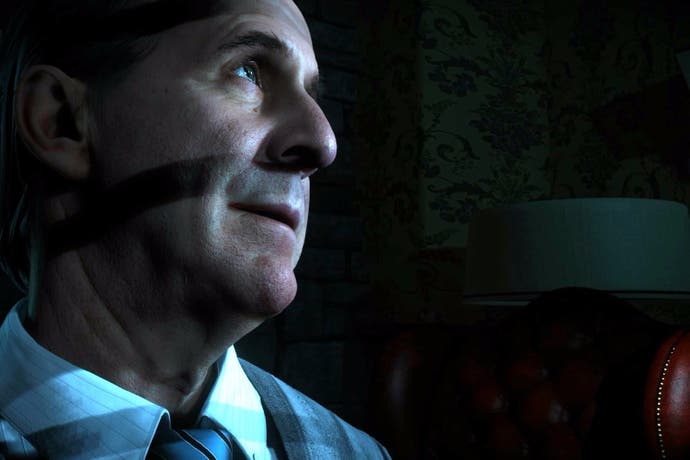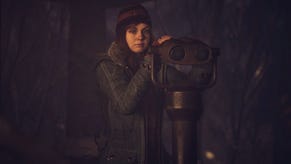Until Dawn review
A cut above.
"Interactive movie" is a troublesome phrase. Games developers have chased this phantom grail for decades, and the result is usually ambitiously flawed at best, absolute dog muck at worst.
David Cage's Quantic Dream studio is one of today's most dedicated proponents of the genre, plugging away with titles like Heavy Rain and Beyond: Two Souls. The problem with Quantic Dream's efforts is that there's always a disconnect between the highbrow intentions - Heavy Rain opens by giving you a Trophy that says "Thank you for supporting digital drama" - and the often ludicrous pulp storylines that intrude as the games progress. Beyond: Two Souls is a tender story about a young woman struggling to find her place in the world, and also a thriller about a psychic secret agent fighting monsters with her invisible ghost bodyguard.
Until Dawn owes a lot to David Cage's work, but it nimbly avoids the perils of the "pretentious" tag by opting for a genre that is famously resistant to such flourishes. It's a horror game, but that's a term that has been almost as abused and twisted over the years as "interactive movie". Let me use the power of HTML tags to make it clear: this is a horror game. It's a smart, witty B-movie that happens to be told in game form.
It leans into every cliché you can think of, right from the opening as a bunch of teenagers head to a remote mountain lodge for a party. A prank backfires, tragedy strikes, and yet one year later the group reunites at the same place to try and maintain their adolescent tradition even in the face of real loss. From there, you get every trope you'd expect. Doors that slam shut by themselves, multiple fake-outs and red herrings, a Ouija board that's dusted off while hints of Native American ritual and magic pepper the margins of the tale.
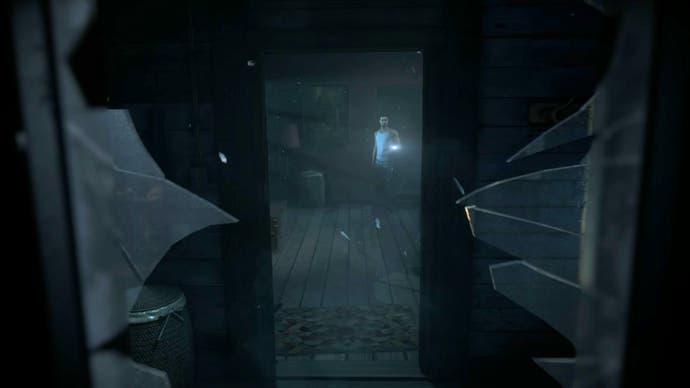
As the player, your task is to guide the eight main characters through their night of terror until the titular deadline arrives. Broken into ten chapters, each of which contains multiple scenes and puts you in control of different characters, the story alters and changes depending on what you do.
Sometimes this means keeping an eye on the relationship between the group members, filled as it is with former lovers, unrequited crushes and macho rivalries. Piss someone off, and they may not offer vital help when you need it. Sometimes your input takes the form of binary choices, some of which are obviously important while the outcome of others is harder to gauge. It may be choosing how to respond to another character, or deciding whether to run or hide when pursued.
And, yes, sometimes things depend on quick-time events, or your ability to perform joypad movements under pressure. These aren't overused, thankfully, and when they are, the presentation and button choices feels organic. Slightly more troublesome are moments where you must hold the controller absolutely still - a task that is harder than it seems thanks to incredibly sensitive motion detection.
Until Dawn is very good at hiding the rails and strings that keep the plot together, with the impact of many choices kept opaque until hindsight makes them clear. Every character can die, it seems, and it's only once you reach the end credits and look back over the "Butterfly Effect" chart which documents your crucial decisions and their eventual payoff, that you appreciate how many routes there are to the ending.
Despite the freedom to make choices (and mistakes) within its boundaries, the story is largely linear. You'll always have a simple objective, usually to get to a certain location, and the path to get there is never complicated or confusing. What leeway you do have to explore is largely due to the game's collectables. These take the form of totems, which provide brief precognitive flashes of possible future events, and also clues, which go towards solving the game's three overlapping mysteries. Finding all of these isn't essential, but making a little effort gives the story a lot more depth.
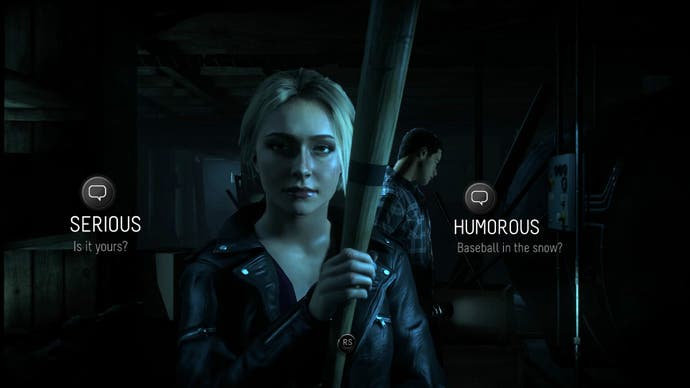
It's hard to talk about that story in too much detail, simply because with any game so heavily reliant on its narrative it's easy to drift into spoiler territory. Suffice to say that while it starts out as a straight "cabin in the woods" slasher riff, drawing on everything from The Evil Dead to Prom Night and My Bloody Valentine, by the end of your nine hour ordeal (which plays out pretty much in real time) it's taken some pretty daring turns away from its starting point. Daring, at least, as far as this particular story is concerned. One of my few problems with how it plays out is that it detours through territory which feels overfamiliar for devoted horror gamers.
That Until Dawn manages to walk this tightrope, albeit wobbling slightly along the way, is down to its script which manages to both stay true to the dumb movies which inspired it, while adding a surprisingly amount of intelligence and emotional depth to characters that are, at their core, pure archetypes. Cult movie director and actor Larry Fessenden co-wrote the script with fellow indie actor Graham Reznick (both also perform in the game), and their affection for the cheesiest horror clichés, and their willingness to twist them into new shapes, is what makes the game more than just another schlocky grindhouse riff.
Their work is well supported by a solid young cast, brought to life (if only to be killed off) by some superb motion capture work. Hayden Panetierre, Rami Malek and Brett Dalton are all not only completely recognisable from their high profile TV work, but give natural and convincing performances, unhindered by the pixels. Of particular note is Peter Stormare, who gives a deliciously unhinged scenery chewing performance as Dr. Hill, a creepy psychiatrist who quizzes a mysterious figure about the unfolding events at the end of each chapter.
You get to give this stranger's responses, and it's here that the game comes closest to breaking the fourth wall. Answers you give about what scares or disgusts you may be reflected in the following chapters, while your opinions on which characters you like or dislike may (or may not) steer them into greater danger. Hill addresses this character, and therefore the player, directly and his commentary on this "sick game" you're playing works on multiple levels. It gets a little too clever for its own good, and doesn't really add much to the game, but Stormare is so barking mad in the role that these interludes are fun all the same.
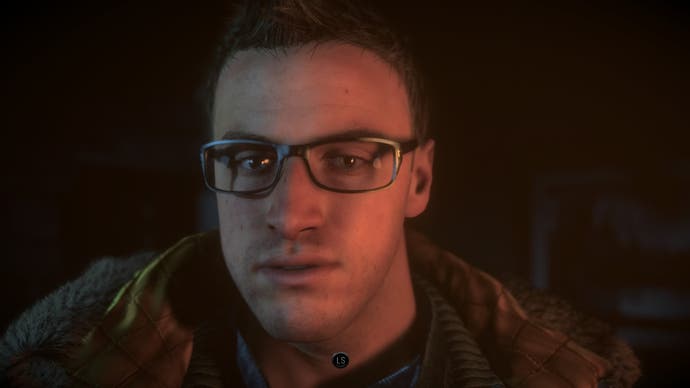
Given that the game relies on our connection to these characters for its impact, it's important we see them as people, not avatars, and countless precision details and little touches make this happen. Up close you can see their pores. They fidget and shuffle, and none of it feels like a canned animation. You can even read their body language to gauge their mood. It's only when guiding them around some of the game's more stubborn scenery items, obscured by the fixed Resident Evil-style cameras, that their digital origins come through and the illusion is briefly broken. Otherwise, aided by some phenomenal set design and stunning lighting, the idea that you're controlling a movie has never been more convincing.
Your willingness to go along with Until Dawn's sometimes wayward, often goofy, plot twists will depend largely on your ability to put up with a few cheap shots, a couple of weird plot holes and a final few chapters that begin to stretch the conceit rather too thin. I devoured it in virtually one sitting, and while my enjoyment wavered along the way, there was always something to pull me back in - not least the fact that it's the first horror game that manages to capture the off-kilter gonzo energy of an indie horror movie.
Until Dawn is an experiment, and sometimes it doesn't work. It throws so much into the mix, veering from backwoods slasher to Saw-style torture porn and even throwing in some old fashioned haunted house frights, that often the most nail-biting aspect is whether or not it can pull it all together into a coherent and (mostly) logical conclusion. That it manages to stick such a difficult landing is reason enough for horror fans, if not everybody else, to celebrate.
It may be over-stuffed, and most of its gameplay ideas have been pioneered elsewhere, but I left Until Dawn with the sense of satisfaction that I usually get from a really fun B-movie, not the sense of completion I get from finishing a game. That may be a warning or a recommendation depending on your tolerance for the dreaded "interactive movie", but there's certainly nothing quite like it around at the moment.
